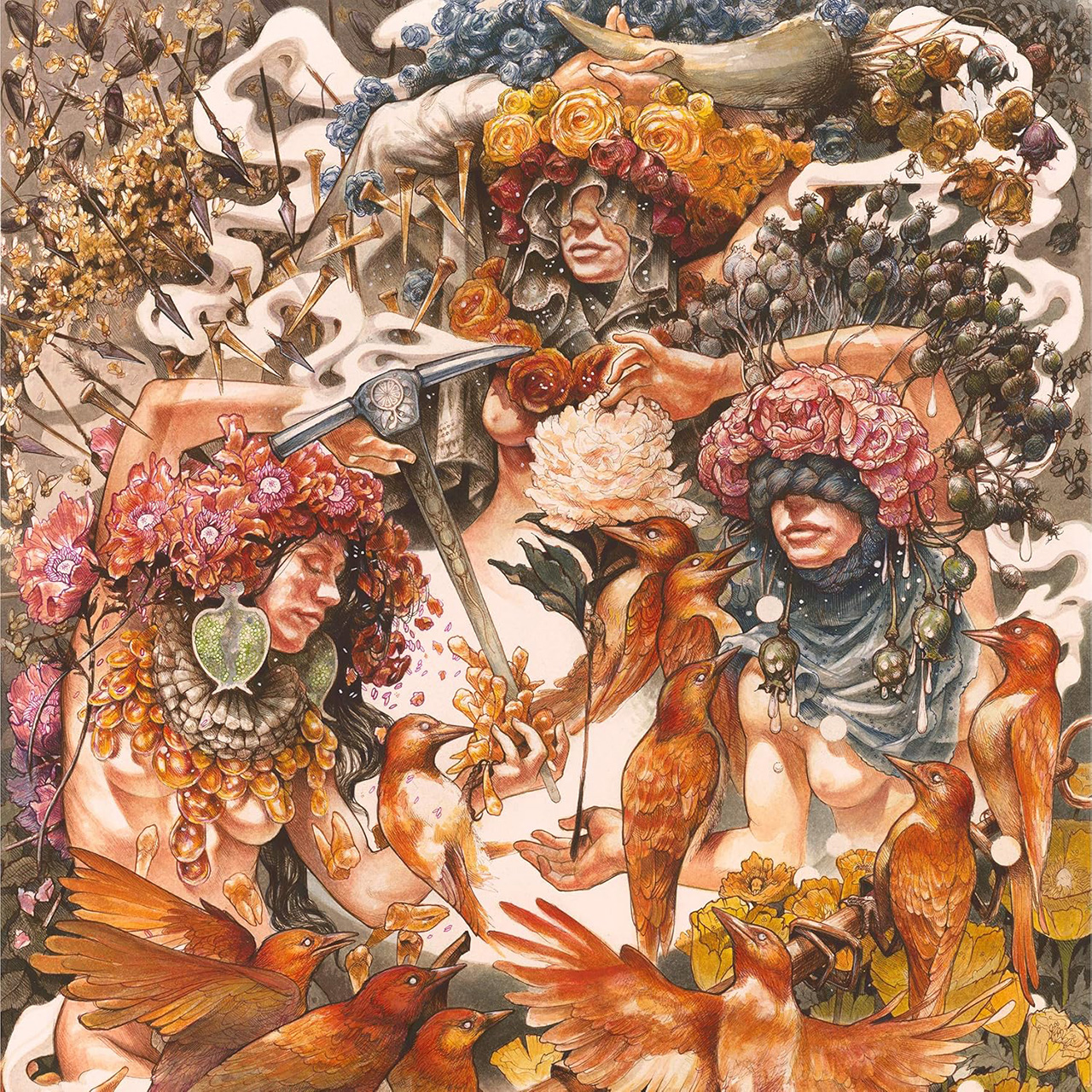
In 2019 Baroness mastermind John Baizley completed a 12-year concept work with the launch of fifth album Gold & Grey. But as he told Prog at the time, he was more excited than intimidated about where the band might go next. Years before 2023 record Stone took shape, Baizley described an approach to art that’s undoubtedly progressive.
John Dyer Baizley is what you might call a modern-day Renaissance man. As the sole constant member of Baroness since their inception in Savannah, Georgia 16 years ago, not only does he continue to steer the band’s musical output with passion and creativity, he also paints their beautifully vivid album artwork. The band’s new, fifth album Gold & Grey closes the chapter of a 12-year-long, colour-coded mega-concept. What could be proggier than that?
For all their progressive tendencies, Baroness began life leaning more towards prog’s nemesis, punk rock, and were active in the Georgian metal scene of the noughties alongside bands like Mastodon – another band who have found a home in the prog world – and Black Tusk.
“We were into punk and classic rock like Thin Lizzy and Led Zeppelin, but we always had an interest in more ‘out- there’ bands,” explains guitarist and vocalist Baizley, mentioning Camel, The Mahavishnu Orchestra, Steve Reich and Comus. It’s clear that this is a man who is seriously excited about all kinds of music across a wide and diverse spectrum.
“Baroness use a lot of musical devices, rhythms and ideas that came from prog, but we were just taking ideas from everything we’d heard; we didn’t realise we were doing things like playing in odd time signatures,” he explains. “We pulled from wherever we could as far as influences: from the Ramones to the most bizarre, technical shit we could find.”
I was very careful that we didn’t get into some of the more traditional concept tropes: the records were never about characters we didn’t know
Over their five albums starting in 2007 – Red Album, Blue Record, Yellow & Green, Purple and now Gold & Grey – Baroness developed their sound so that it’s now instantly recognisable: led by Baizley’s captivating drawl, they make progressive sludge that is both dizzyingly technical and dazzlingly beautiful, a rich sound that is somehow simultaneously unpredictable yet carefully controlled. And all of it was created around a concept – working through the shades of a traditional colour wheel, while taking a note out of Led Zeppelin’s book.
“I always had this love affair with the first four Led Zeppelin records, and I love how simple and efficient the titles were,” Baizley explains. “How they didn’t explain anything about the music, but there was a numerology so you felt like the records were a set. But also if I said Led Zeppelin II or IV it would bring to mind this huge world of whatever record that was without any clue other than a number.
“Colours were the visual language that I spoke. When we talked about concepts I was very careful that we didn’t get into some of the more traditional concept tropes: the records were never about characters we didn’t know. The songs were all about personal things in my life, but we adopted a more poetic language. We then found that the records would take on some of the loose ideologies and concepts of these colours; it became a fun thing to do.”
Given Baizley’s connection to the visual, it’s no surprise he creates elaborate artwork for the cover of each Baroness album, as well as for other artists like Kvelertak and Kylesa. A student of art history, his style is like art nouveau gone heavy metal – vibrant paintings depict women, animals and nature, with the colour palette of each cover correlating with its title.
“Both musically and artistically, my style is a byproduct of being open- minded, and always making an attempt to subvert the standard use of imagery, colour or symbolism,” Baizley explains. “I take images that you and I and everybody – regardless of culture, gender, social or political background – would recognise. Such images tend to get hyper-loaded with meaning over time, so I twist and turn in order to tell a unique story.
You get people in a room and we all celebrate, we all cry, we all sing, whatever. But then you wonder, ‘Is there more to it?’ and I’d like to think that yes, there is
“The end goal is that the audience recognise something familiar, but ultimately are shown something that hopefully has an element of newness; that makes you question every version of this reference point. That’s ambitious... but why not be ambitious!?”
In reference to the Gold & Grey cover, Baizley mentions symbols from the lyrics, numerology, east meets west, a north-south axis... but doesn’t want to give too much away. “I choose not to over-articulate,” he says. “I don’t want to ruin somebody else’s experience. People trying to imbue their own meaning has given me justification for continuing to do this. That’s the goal: to create something that compels people to reflect.
“You get people in a room and we all celebrate, we all cry, we all sing, whatever. But then you wonder, ‘Is there more to it?’ and I’d like to think that yes, there is.”
Gold & Grey is a 17-song grand summation of the Baroness sound, which Baizley insists won’t make sense until you’ve listened to it at least four times. “I like to really push against our audience, against ourselves, against our producer and against expectations – and see how far that can go just before it breaks,” Baizley says.
“When you’re younger you don’t have that sense of things; there’s this real tendency to overwork songs. So we got right up to that point where it would have been too much and then we stopped, in my opinion. We wanted to make something that we had never heard anyone else do: something that made us feel slightly alien with our instruments.
“On just about every song on the record there is an element of odd,” Baizley says of Gold & Grey. “On one song that Sebastian [Thomson, drummer] and I wrote, Tourniquet, Sebastian chose to play the 4/4 beat with a kick drum every fifth beat. It’s fucking weird! Gina [Gleason, guitar] and I would do these dense chord clusters where every single thing I’m playing is an inversion of what she’s playing.
“It’s such a complex record. If you’re into guitar, give Cold-Blooded Angels a shot. See if you can figure that out. My hat’s off to you if you can, because Gina and I can barely figure out how we did that!”
Dealing with the after-effects of the crash has been such a complicated thing, and I have trouble verbalising it. But through music I found a platform
Gold & Grey is the first release with the new Baroness line-up: Gleason, who’s toured with Jon Anderson, joined in 2017; and Nick Jost [bass] and Thomson joined in 2013, when the future of Baroness was very much up in the air. The previous year, just a month after the release of Yellow & Green, the band were involved in a serious tour bus crash in Bath, UK. Thankfully there were no fatalities, but Baizley broke his arm and leg, unsure if he would or could ever play music again, and the rest of the members at the time left the band soon after.
“I’m not saying this is for better or for worse, but everything in my life now orbits around that moment,” Baizley says. “It was dramatic, long-lasting and had very negative effects on me both physically and mentally. Fortunately, it doesn’t seem like it had a negative effect creatively. Purple [2015] was my platform to rehabilitate, and it seems to me that Gold & Grey offers me introspection and reflection on what happened.”

Did the after-effects of such a traumatic event ever make him want to stop Baroness? “It was painful, but it was never too painful,” he says firmly. “Aside from my family, I felt certain that music was the only thing I should not give up on. Dealing with the after-effects of that event has been such a complicated, labyrinthian thing, and I have trouble verbalising it. But through music, through the arts, I found a platform where I can relay those thoughts and feelings. So for me, the music has really kept me going.”
If you look at a colour wheel, you’ll see orange sits next to red. The cover of Gold & Grey is bursting with shades of orange, closing the chapter on the cycle that began with Red Album back in 2007. So where does Baizley plan to take Baroness next if this project is complete?
We could do a thrash record, electronic, something chilled, something heavy and aggressive, maybe a bit of everything!
“I’m as curious as anyone else!” he laughs. “I’ve spent 12 years considering that idea when releasing each record. This is the first time in my career where I’ve not had my eye towards the future.
“I think with Gold & Grey, one of the most important things that we did was release a record that allows a great amount of leeway in the immediate future with regards to whatever our next album could be. We could do a thrash record, electronic, something chilled, something heavy and aggressive, maybe a bit of everything!
“In the immediate future we still have to sit down and figure out how to play all of these new songs. One important aspect of Baroness is that we see ourselves as a live band. In order to live up to our own expectation we have to play to a fairly high intensity, energy and technical level, and it’s a record that can only be played if you’re fully aware of what you’re doing. It’s a trip!”







